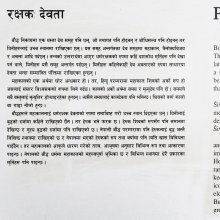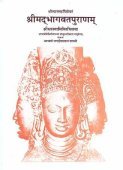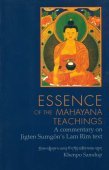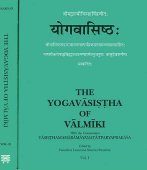Samsara, Sansara, Sansāra, Sangsara, Samsāra, Saṃsāra, Samshara: 34 definitions
Introduction:
Samsara means something in Buddhism, Pali, Hinduism, Sanskrit, Jainism, Prakrit, the history of ancient India, Marathi, Hindi. If you want to know the exact meaning, history, etymology or English translation of this term then check out the descriptions on this page. Add your comment or reference to a book if you want to contribute to this summary article.
Alternative spellings of this word include Sansar.
Images (photo gallery)
In Hinduism
Purana and Itihasa (epic history)
Source: archive.org: Puranic EncyclopediaSaṃsāra (संसार).—One in the line of Gurus. (See under Guruparaṃpara).
Source: Cologne Digital Sanskrit Dictionaries: The Purana Index1a) Saṃsāra (संसार).—Compared to an ocean; the evils of family life as explained by the king of mountains; the necessity of children, the difficulty and anxiety in procuring good husbands for daughters, etc;1 the duhham of, explained.2
1b) (tāmasa) of six kinds—man, animal (paśu), beast (mṛga), bird (pakṣi), snake (sarīsṛpu) and vegetation (sthāvara); sātvikam: Brahmā and others; rājasam—the intervening viṣṭambhaka among the 14 sthānas.*
- * Vāyu-purāṇa 14. 35-41; 100. 203.

The Purana (पुराण, purāṇas) refers to Sanskrit literature preserving ancient India’s vast cultural history, including historical legends, religious ceremonies, various arts and sciences. The eighteen mahapuranas total over 400,000 shlokas (metrical couplets) and date to at least several centuries BCE.
Shaivism (Shaiva philosophy)
Source: Brill: Śaivism and the Tantric TraditionsSaṃsāra (संसार) refers to “(the great tree of) transmigration”, according to the Vārāṇasīmāhātmya verse 1.114.—Accordingly, “The great tree of transmigration (saṃsāra-viṭapa) has arisen from the seed of desire. After cutting the tree with the axe of indifference, whose sharp blade is disattachment, they proceed on the Atimārga”.

Shaiva (शैव, śaiva) or Shaivism (śaivism) represents a tradition of Hinduism worshiping Shiva as the supreme being. Closely related to Shaktism, Shaiva literature includes a range of scriptures, including Tantras, while the root of this tradition may be traced back to the ancient Vedas.
Shaktism (Shakta philosophy)
Source: Brill: Śaivism and the Tantric Traditions (shaktism)Saṃsāra (संसार) refers to “transmigration”, according to Sāhib Kaul’s Śārikāstrotra.—Accordingly, “With true devotion I worship that divine and omnipresent Śārikā, who bears the crescent moon on her head, who grants liberation, destroys delusion everywhere, destroys the bad fear of meeting a wrong death. O mother Śārikā, whoever devotedly recites your tāra-syllable, which carries one across the ocean of transmigration (saṃsāra-abdhi), may, when his wisdom is ripened through the knowledge of the absolute, even put to shame the Lord of the Word. [...]”.

Shakta (शाक्त, śākta) or Shaktism (śāktism) represents a tradition of Hinduism where the Goddess (Devi) is revered and worshipped. Shakta literature includes a range of scriptures, including various Agamas and Tantras, although its roots may be traced back to the Vedas.
Ayurveda (science of life)
Rasashastra (Alchemy and Herbo-Mineral preparations)
Source: History of Science in South Asia: Making Gems in Indian Alchemical LiteratureSaṃsāra (संसार) refers to the “world of rebirth”, according to the Vādakhaṇḍa section of the Rasaratnākara (lit. “jewel mine of mercury”): a 13th century alchemical work in Sanskrit written by Nityanātha.—Accordingly, “In the world of rebirth (saṃsāra), very abundant wealth is indeed the most excellent thing, producing all pleasures; that is to be attained by lords of sādhakas. According to the method from the mouth of the teacher, specifically the manufacture of jewels, etc., and the auspicious lore of perfumery is related here for the purpose of attaining it. For, having understood everything, those various things are easily attained, being in the direct experience [and] purifying for wise ones”.

Āyurveda (आयुर्वेद, ayurveda) is a branch of Indian science dealing with medicine, herbalism, taxology, anatomy, surgery, alchemy and related topics. Traditional practice of Āyurveda in ancient India dates back to at least the first millenium BC. Literature is commonly written in Sanskrit using various poetic metres.
General definition (in Hinduism)
Source: WikiPedia: HinduismSamsara (संसार): Means wandering, The tree worlds constitute Samsara. Refers to the concept of reincarnation or rebirth in Indian philosophical traditions.
In Buddhism
Theravada (major branch of Buddhism)
Source: Access to Insight: A Glossary of Pali and Buddhist TermsTransmigration; the round of death and rebirth. See vatta.Source: Pali Kanon: Manual of Buddhist Terms and DoctrinesSamsāra (“round of rebirth”), lit. “perpetual wandering”, is a name by which is designated the sea of life ever restlessly heaving up and down, the symbol of this continuous process of ever again and again being born, growing old, suffering and dying. More precisely put, samsāra is the unbroken chain of the five-fold khandha-combinations, which, constantly changing from moment to moment follow continuously one upon the other through inconceivable periods of time.
Of this samsāra, a single lifetime constitutes only a tiny and fleeting fraction; hence to be able to comprehend the first noble truth of universal suffering, one must let one's gaze rest upon the samsāra, upon this frightful chain of rebirths, and not merely upon one single life-time, which, of course, may be sometimes less painful.
Cf. tilakkhana, anattā, paramattha, patisandhi.
Theravāda is a major branch of Buddhism having the the Pali canon (tipitaka) as their canonical literature, which includes the vinaya-pitaka (monastic rules), the sutta-pitaka (Buddhist sermons) and the abhidhamma-pitaka (philosophy and psychology).
General definition (in Buddhism)
Source: Wisdom Library: BuddhismSaṃsāra (संसार, “continuous movement”) or “continuous flowing”.—Saṃsāra means the concept of a cycle of birth (jāti). All beings in the universe apply to its rules, and can only be escaped through enlightenment. According to Buddha there is no starting/ending point of Saṃsāra, just like a circle.
Source: Buddhist Door: GlossarySanskrit word meaning turning of the wheel or revolving. It refers to the transmigration in the Six Directions of Reincarnation, the realm of birth and death.Source: Amaravati: Glossary(sang sah ra)the unenlightened, unsatisfactory experience of life; the world as conditioned by ignorance.
Source: Shambala Publications: General1. Samsāra (samsāra), Skt., lit., “journeying”; the “cycle of existences,” a succession of rebirths that a being goes through within the various modes of existence until it has attained liberation and entered nirvāna. Imprisonment in samsāra is conditioned by the three “unwholesome roots” : hatred (dvesha), desire or craving (trishnā), and delusion (avidyā). The type of rebirth within samsāra is determined by the karma of the being. In the Mahāyāna, samsāra refers to the phenomenal world and is considered to be essentially identical with nirvāna.
2. Samsara (Skt.) is cyclic existence, in which—owing to the corrupting influence of the mental delusions of hatred, desire, and ignorance—sentient creatures are compelled to wander from one life form to another without respite until they meet up with the spiritual path.
In Jainism
Jain philosophy
Source: archive.org: Anekanta Jaya Pataka of Haribhadra SuriSaṃsāra (संसार) refers to one of the twelve reflections (bhāvanā), as mentioned in the Anekāntajayapatākā-prakaraṇa, a Śvetāmbara Jain philosophical work written by Haribhadra Sūri.—[Cf. Vol. II, P. 223, ll. 22-25]—Saṃsāra-bhāvanā refers to the reflection that—The mundane soul is ever wandering in this world, and it is subject to the cycle of various existences, full of miseries and sufferings So it can attain true and perfect happiness when it is out of it.
-
General definition (in Jainism)
Source: archive.org: TrisastisalakapurusacaritraSaṃsāra (संसार) refers to “worldly existence”, according to chapter 4.5 [dharmanātha-caritra] of Hemacandra’s 11th century Triṣaṣṭiśalākāpuruṣacaritra: an ancient Sanskrit epic poem narrating the history and legends of sixty-three illustrious persons in Jainism.
Accordingly, as Dharma-nātha said in his sermon on the kaṣāyas:—“[...] This very soul, consisting of pure thought, has a body from union with karma, but may become perfect soul, spotless, having its karma consumed by the fire of meditation. This same soul, overcome by passions and the senses is saṃsāra (worldly existence); and wise men call the very same, when it overcomes the passions and senses, mokṣa (emancipation)”.
Source: Encyclopedia of Jainism: Tattvartha Sutra 2: the Category of the livingSaṃsāra (संसार).—What is the meaning of saṃsāra (transmigration)? The entity in which transmigration takes place. It can also be called as change /transmigration. (see Tattvārthasūtra 2.10)
Source: The University of Sydney: A study of the Twelve Reflections1a) Saṃsāra (संसार) (Cf. Bhava) refers to the “cycle of births sand rebirths” and represents one of the twelve pure reflections (bhāvanā), according to the Praśamaratiprakaraṇa 149-50 (p. 93-4).—Accordingly, “(A monk) should reflect, upon transcient [sic] nature of the world, helplessness, loneliness, separateness of the self from non-self, impurity (of the body), cycle of births sand [sic] rebirths (saṃsāra), inflow of Karmas and stoppage of inflow of Karmas; Shedding of stock of Karmas, constitution of the universe, nature of true religion, difficulty in obtaining enlightenment, which are (called) twelve pure Bhāvanās (reflections)”.
1b) Saṃsāra (संसार) refers to the “cycle of rebirth” and represents one of the “(twelve) reflections” (bhāvanā), according to the 11th century Jñānārṇava, a treatise on Jain Yoga in roughly 2200 Sanskrit verses composed by Śubhacandra.—[...] The cycle of rebirth (saṃsāra) deceives sentient beings who experience the lowest and highest modes of existence in a lifetime. A god becomes filled with sadness, a dog ascends to heaven and a Brahmin might become a dog or an insect or even a low-born outcaste. Like an actor on the stage, an embodied soul constantly assumes different characters and relinquishes others. Inflamed by intense pleasure and oppressed by wrong faith, sentient beings wander about in a life that is full of difficulty.
2) Saṃsāra (संसार) (in both Prakrit and Sanksrit) also refers to “(reflection on) the cycle of rebirth” and represents one of the four types of “virtuous meditation” (dhammajhāṇa), a classification of the “meditation” (Jhāṇa), according to the Sthānāṅga Sūtra chapter 4.1.—The classification of meditation in the Sthānāṅga Sūtra comprises four kinds [e.g. “virtuous” (dhamma/dharma)]. [...] The four reflections that are prescribed for virtuous meditation are (dhammajhāṇa), [e.g., reflection on the cycle of rebirth (saṃsāra-aṇuppehā/saṃsāra-anuprekṣā), ...].—Cf Aupapātika Sūtra and Bhagavatī (Bhagavaī), also known as the Vyākhyāprajñapti (Viyāhapannatti).
Source: academia.edu: Tessitori Collection ISaṃsāra (संसार) refers to “(reflection on the) world of transmigrations” and represents one of the twelve Bhāvanās (topics for meditation), according to a manuscript [Bāra bhāvanā] (dealing with the Ethics section of Jain Canonical literature) included in the collection of manuscripts at the ‘Vincenzo Joppi’ library, collected by Luigi Pio Tessitori during his visit to Rajasthan between 1914 and 1919.—There are traditionally 12 bhāvanās or topics for meditation (also known as anuprekṣā, see Tattvārthasūtra 9.7 as locus classicus). In the present manuscript [Bāra bhāvanā], only the first six are dealt with, each in a few stanzas, followed by a section-title: [e.g.,] . 3. reflection on the world of transmigrations (saṃsāra, 5 stanzas, ends on 50r12). [...]

Jainism is an Indian religion of Dharma whose doctrine revolves around harmlessness (ahimsa) towards every living being. The two major branches (Digambara and Svetambara) of Jainism stimulate self-control (or, shramana, ‘self-reliance’) and spiritual development through a path of peace for the soul to progess to the ultimate goal.
India history and geography
Source: Project Gutenberg: Castes and Tribes of Southern India, Volume 1Samsara (“family”) is one of the gotras (clans) among the Kurnis (a tribe of South India). Kurni is, according to the Census Report 1901, “a corruption of kuri (sheep) and vanni (wool), the caste having been originally weavers of wool”. The gotras (viz., Samsara) are described as being of the Brāhman, Kshatriya, and Vaisya sub-divisions of the caste, and of Shanmukha’s Sudra caste.

The history of India traces the identification of countries, villages, towns and other regions of India, as well as mythology, zoology, royal dynasties, rulers, tribes, local festivities and traditions and regional languages. Ancient India enjoyed religious freedom and encourages the path of Dharma, a concept common to Buddhism, Hinduism, and Jainism.
Languages of India and abroad
Pali-English dictionary
Source: BuddhaSasana: Concise Pali-English Dictionarysaṃsāra : (m.) faring on; transmigration.

Pali is the language of the Tipiṭaka, which is the sacred canon of Theravāda Buddhism and contains much of the Buddha’s speech. Closeley related to Sanskrit, both languages are used interchangeably between religions.
Marathi-English dictionary
Source: DDSA: The Molesworth Marathi and English Dictionarysaṃsāra (संसार).—m (S) The world, mundane existence, human life, man's mortal state. 2 The affairs of life; worldly business; the vocations and engagements, the cares and troubles of secularity. saṃ0 vṛthā jāṇēṃ g. of s. To have one's worldly affairs or secular standing ruined or marred; to lose one's life Ex. tukayācī jyēṣṭha kāntā || mēlī anna anna karitāṃ || yēṇēṃ lajjā vāṭē cittā || saṃ0 vṛthā gēlā kīṃ ||. saṃ0 hākaṇēṃ To manage the worldly affairs. saṃsā- rācī mātrā karaṇēṃ To blast the affairs, hopes, and prospects of, to ruin.
Source: DDSA: The Aryabhusan school dictionary, Marathi-Englishsaṃsāra (संसार).—n The world; the affairs of life. saṃsāra hākaṇēṃ Manage the worldly affairs. saṃsārācī mātrā karaṇēṃ To ruin.
Marathi is an Indo-European language having over 70 million native speakers people in (predominantly) Maharashtra India. Marathi, like many other Indo-Aryan languages, evolved from early forms of Prakrit, which itself is a subset of Sanskrit, one of the most ancient languages of the world.
Sanskrit dictionary
Source: DDSA: The practical Sanskrit-English dictionarySaṃsāra (संसार).—
1) Course, passage.
2) The course or circuit of worldly life, secular life, mundance existence, the world; न स तत् पदमाप्नोति संसारं चाधिगन्छति (na sa tat padamāpnoti saṃsāraṃ cādhiganchati) Kath. 3.7; असासः संसारः (asāsaḥ saṃsāraḥ) Uttararāmacarita 1; Mālatīmādhava (Bombay) 5.3; संसारधन्वभुवि किं सारमामृशसि शंसाधुना शुभमते (saṃsāradhanvabhuvi kiṃ sāramāmṛśasi śaṃsādhunā śubhamate) Aśvad.22; or परिवर्तिनि संसारे मृतः को वा न जायते (parivartini saṃsāre mṛtaḥ ko vā na jāyate) Pañcatantra (Bombay) 1.27.
3) Transmigration, metempsychosis, succession of births.
4) Worldly illusion.
5) The state (future) of life (gati); येन यस्तु गुणेनैषां संसारान् प्रतिपद्यते (yena yastu guṇenaiṣāṃ saṃsārān pratipadyate) Manusmṛti 12.39.
Derivable forms: saṃsāraḥ (संसारः).
Source: Cologne Digital Sanskrit Dictionaries: Edgerton Buddhist Hybrid Sanskrit DictionarySaṃsāra (संसार).—name of a householder's son of Śrāvastī: Avadāna-śataka ii.161.13 ff.
Source: Cologne Digital Sanskrit Dictionaries: Shabda-Sagara Sanskrit-English DictionarySaṃsāra (संसार).—m.
(-raḥ) 1. The world, the habitation of mortals. 2. Mundane existence. 3. A succession of births or existences. 4. Transmigration, metempsychosis. 5. Wordly illusion. 6. Secular life. 7. Course, passage. E. sam together, (mankind,) sṛ to go, aff. ghañ .
Source: Cologne Digital Sanskrit Dictionaries: Benfey Sanskrit-English DictionarySaṃsāra (संसार).—i. e. sam-sṛ + a, m. 1. Transmigration, [Mānavadharmaśāstra] 12, 40. 2. Mundane existence, [Pañcatantra] 165, 17. 3. The world, [Hitopadeśa] pr. [distich] 14, M. M.
Source: Cologne Digital Sanskrit Dictionaries: Cappeller Sanskrit-English DictionarySaṃśara (संशर).—[masculine] breaking down, tearing asunder.
--- OR ---
Saṃsāra (संसार).—[masculine] wandering, [especially] from one existence into another, metempsychosis, transmigration, the cycle of existence; life i.[grammar]
Source: Cologne Digital Sanskrit Dictionaries: Monier-Williams Sanskrit-English Dictionary1) Saṃśara (संशर):—[=saṃ-śara] a saṃ-śāruka See saṃ√sṝ, p.1118col.1.
2) [=saṃ-śara] [from saṃ-śṝ] b m. crushing, breaking, rending, [Vājasaneyi-saṃhitā; Taittirīya-brāhmaṇa]
3) Saṃsāra (संसार):—[=saṃ-sāra] a etc. See saṃ-√sṛ below.
4) [=saṃ-sāra] [from saṃ-sṛ] b m. going or wandering through, undergoing transmigration, [Maitrī-upaniṣad]
5) [v.s. ...] course, passage, passing through a succession of states, circuit of mundane existence, transmigration, metempsychosis, the world, secular life, worldly illusion (ā saṃsārāt, ‘from the beginning of the world’), [Upaniṣad; Manu-smṛti; Mahābhārata] etc.
6) [v.s. ...] [wrong reading] for saṃ-cāra, [Bhartṛhari]
Source: Cologne Digital Sanskrit Dictionaries: Yates Sanskrit-English DictionarySaṃsāra (संसार):—[saṃ-sāra] (raḥ) 1. m. The world; mundane existence.
Source: DDSA: Paia-sadda-mahannavo; a comprehensive Prakrit Hindi dictionary (S)Saṃsāra (संसार) in the Sanskrit language is related to the Prakrit word: Saṃsāra.
[Sanskrit to German]
Sanskrit, also spelled संस्कृतम् (saṃskṛtam), is an ancient language of India commonly seen as the grandmother of the Indo-European language family (even English!). Closely allied with Prakrit and Pali, Sanskrit is more exhaustive in both grammar and terms and has the most extensive collection of literature in the world, greatly surpassing its sister-languages Greek and Latin.
Hindi dictionary
Source: DDSA: A practical Hindi-English dictionarySaṃsāra (संसार) [Also spelled sansar]:—(nm) the world; -[cakra] circuit of worldly existence; -[baṃdhana] the worldly fetters; —[sāgara] the ocean of the world; —[choḍanā/tyāganā] to renounce the world; to depart for the other world; —[se uṭha jānā/cale jānā/vidā honā] to expire.
...
Prakrit-English dictionary
Source: DDSA: Paia-sadda-mahannavo; a comprehensive Prakrit Hindi dictionary1) Saṃsara (संसर) in the Prakrit language is related to the Sanskrit word: Saṃsṛ.
2) Saṃsāra (संसार) also relates to the Sanskrit word: Saṃsāra.
Prakrit is an ancient language closely associated with both Pali and Sanskrit. Jain literature is often composed in this language or sub-dialects, such as the Agamas and their commentaries which are written in Ardhamagadhi and Maharashtri Prakrit. The earliest extant texts can be dated to as early as the 4th century BCE although core portions might be older.
Kannada-English dictionary
Source: Alar: Kannada-English corpusSaṃsara (ಸಂಸರ):—[noun] the endless cycle of births, deaths that an individual soul has to go through.
--- OR ---
Saṃsāra (ಸಂಸಾರ):—
1) [noun] a way, path or channel of movement; a course.
2) [noun] the fact of being born or coming into life; birth.
3) [noun] a social unit consisting of parents and the children; a family.
4) [noun] a woman as related to her husband; a wife.
5) [noun] the mundane life.
6) [noun] the domestic affairs (of a person or family).
7) [noun] the physical world.
8) [noun] '(biol.) a category in the classification of plants or animals, ranking above a genus and below an order and including one or more similar genera: a family.'9) [noun] the endless cycle of births and deaths that indiidual soul has to go through (till final emancipation).
Kannada is a Dravidian language (as opposed to the Indo-European language family) mainly spoken in the southwestern region of India.
Nepali dictionary
Source: unoes: Nepali-English Dictionary1) Saṃsāra (संसार):—n. 1. the phenomenal universe; 2. the endless round of birth; death; and rebirth from which Hindus seek release;
2) Sansara (सन्सर):—n. Saturn;
3) Sansāra (सन्सार):—n. → संसार [saṃsāra]
Nepali is the primary language of the Nepalese people counting almost 20 million native speakers. The country of Nepal is situated in the Himalaya mountain range to the north of India.
See also (Relevant definitions)
Partial matches: Sara, Sam, Cara.
Starts with (+89): Camcarajivan, Camcaram, Samsarabandhana, Samsarabdhi, Samsarabhana, Samsarabhara, Samsarabhavana, Samsarabhaya, Samsarabhiru, Samsarabhirutva, Samsarabhita, Samsarabhrama, Samsarabhramana, Samsarabija, Samsaraca Gada, Samsaracakka, Samsaracakra, Samsaracandra bhupa, Samsaracarita, Samsaracem Jokhada.
Ends with: Abhisamsara, Amgasamsara, Anosamsara, Anusamsara, Anusamsara, Asamsara, Bhutasamsara, Edasamsara, Gharasamsara, Ghorasamsara, Hatavaraca Samsara, Hatavaraca-samsara, Ihasamsara, Jatisamsara, Nissamsara, Nosamsara, Purviya-samsara, Ucalala Samsara.
Full-text (+882): Samsaramarga, Samsarika, Samsaraguru, Samsaragamana, Vatta, Samsaramoksha, Samsarasara, Samsaradevi, Samsaratarani, Samsaravartman, Samsarasagara, Samsarasarani, Samsaranirnaya, Samsaraparitapa, Samsarakantara, Samsarasamudra, Samsaravana, Samsarasanga, Samsaramuktikaranavada, Samsarasukha.
Relevant text
Search found 241 books and stories containing Samsara, Sansara, Sansāra, Sangsara, Samsāra, Saṃsāra, Samshara, Saṃśara, Sam-shara, Saṃ-śara, Sam-sara, Saṃ-sāra, Saṃsara; (plurals include: Samsaras, Sansaras, Sansāras, Sangsaras, Samsāras, Saṃsāras, Samsharas, Saṃśaras, sharas, śaras, saras, sāras, Saṃsaras). You can also click to the full overview containing English textual excerpts. Below are direct links for the most relevant articles:
Hari-bhakti-kalpa-latikā (by Sarasvati Thkura)
Dhammapada (Illustrated) (by Ven. Weagoda Sarada Maha Thero)
Verse 153-154 - Venerable Ānanda’s Stanzas < [Chapter 11 - Jarā Vagga (Old Age)]
Verse 414 - Seven Years in the Womb < [Chapter 26 - Brāhmaṇa Vagga (The Brāhmaṇa)]
Verse 302 - The Story of the Monk from the Country of the Vajjis < [Chapter 21 - Pakiṇṇaka Vagga (Miscellaneous)]
Malatimadhava (study) (by Jintu Moni Dutta)
Part 4.3b - Ojas Guṇa (Floridity) < [Chapter 2 - Literary Study of the Mālatīmādhava]
Part 2.3a - Śabdālaṃkāra (Figure of Word) < [Chapter 2 - Literary Study of the Mālatīmādhava]
Taittiriya Upanishad Bhashya Vartika (by R. Balasubramanian)
Verse 3.31 < [Book 3 - Bhṛguvallī]
Verse 3.70 < [Book 3 - Bhṛguvallī]
Verse 2.218 < [Book 2 - Brahmavallī]
Brahma Sutras (Shankaracharya) (by George Thibaut)
II, 2, 41 < [Second Adhyāya, Second Pāda]
I, 3, 30 < [First Adhyāya, Third Pāda]
IV, 2, 8 < [Fourth Adhyāya, Second Pāda]
Taittiriya Upanishad (by A. Mahadeva Sastri)
Lesson X - The Illumination < [Book I - Shiksha Valli]
Chapter II - Brahma-vidyā in a Nutshell < [A - Brahmavidyā expounded]
Chapter IV - Final Attainment < [Book III - Bhriguvalli]
Related products




